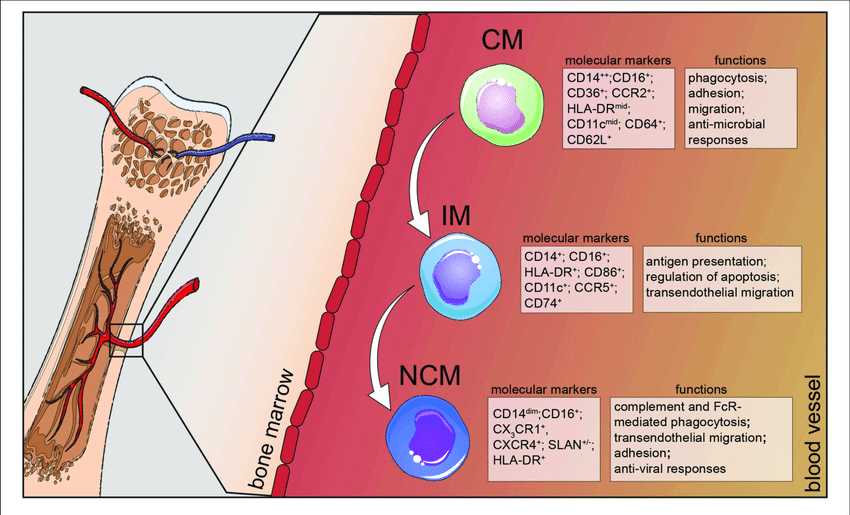Monocyte Markers
Related Symbol Search List
- CD14
- IL-10
- ITGAM
- ITGAX
- Thrombopoietin
- CCR2
- CCR5
- CD16a
- FCGR3B
- CD45
- LILRA4
- CD147
- CD244
- ITGA4
- LTBR
- LTB4R
- SPN
- Anpep
- CD53
- CD93
- CSF3R
- MS4A2
- PTPRJ
- S100A8
- S100A9
- L-selectin
- Selplg
- CD68
- CXCR1
- CXCR6
- LILRA5
- TREM1
- ENG
- CXCR4
- CD163
- CD300A
- CD300C
- CD300E
- CD300LB
- CD300LF
- CD33
- CD36
- CD84
- Carboxypeptidase M
- Integrin beta 3
- LILRA3
- LILRB1
- ILT4
- LILRB3
- LRP1
- Ly86
- LY96
- NUP85
- PVR
- LIMPII
- TREM2
- TREML1
- ALCAM
- CCR1
- CCR8
- Cd180
- CD226
- CSF1R
- F3
- CD89
- IL10RB
- IL11
- IL36A
- Il6ra
- ITGA3
- L1CAM
- LAIR1
- LAIR2
- LILRA2
- MRC1
- HVEM
Immunology Background
About Monocyte Markers
Monocyte markers are specific proteins or molecules that are expressed on the surface of monocytes, which are a type of white blood cell. Monocytes are an important component of the immune system and play a crucial role in immune responses, including the clearance of pathogens and the initiation of inflammation.
Human monocytes mature in the bone marrow and are subsequently released into the circulation as CD14 + classical monocytes. Progressively, classical monocytes (CD14+ CD16−) give rise to non-classical monocytes (CD14 dim CD16+) through an intermediate step of CD14 + CD16 + monocytes. Classical monocytes in humans can be distinguished from the other two subsets by additional markers, such as CD36, CCR2, and CD64, and take part in the host's anti-microbial responses, such as adhesion to the endothelium, migration, and phagocytosis. Intermediate monocytes are characterized by their high expression of CCR5 and HLA-DR molecules and are involved in antigen processing and presentation and transendothelial migration. Non-classical monocytes divide into a SLAN + and a SLAN − population, express high levels of CX 3 CR1, and specialize in complement and FcR-mediated phagocytosis, transendothelial migration, and anti-viral responses.
 Fig. 1 Human monocyte subsets in health. (Theodore S. Kapellos, et al., 2019)
Fig. 1 Human monocyte subsets in health. (Theodore S. Kapellos, et al., 2019)
CM, classical monocytes; IM, intermediate monocytes; NCM, non-classical monocytes.
There are several different markers that can be used to identify and characterize monocytes. Some of the most commonly used markers include CD14, CD16, CD11b, CD64, and HLA-DR. These markers are typically detected by flow cytometry, a technique that uses antibodies labeled with fluorescent tags to bind to specific surface molecules.
CD14 is a well-known monocyte marker that is expressed on the surface of most, but not all, monocytes. It plays a key role in the detection of bacterial lipopolysaccharides and the activation of monocytes in response to infection. CD16, also known as FcγRIII, is another monocyte marker that is expressed on a subset of monocytes known as "non-classical" or "patrolling" monocytes. CD16 is involved in antibody-dependent cell-mediated cytotoxicity and phagocytosis.
CD11b, also known as integrin alpha M, is a marker that is expressed on the surface of monocytes as well as other myeloid cells. It is involved in cell adhesion and migration and plays a role in the recruitment of monocytes to inflammatory sites. CD64, or FcγRI, is another monocyte marker that is involved in antibody-dependent cell-mediated phagocytosis. Finally, HLA-DR is a marker of antigen-presenting cells, including monocytes, which are capable of presenting antigens to activate T cells.
By analyzing the expression of these markers, researchers can distinguish different subsets of monocytes and gain insights into their functions and roles in immune responses. Monocyte markers are also used in clinical settings to diagnose and monitor certain diseases, such as inflammatory disorders and certain types of cancer.
Physiological Functions and Application Areas of Monocyte Markers
Monocyte markers play important roles in understanding the functions and behavior of monocytes in various physiological and pathological conditions. These markers help identify and characterize monocytes, allowing researchers to investigate their roles in immune responses, inflammation, and disease processes. Here are some functions and application areas of monocyte markers:
Identification and Enumeration: Monocyte markers such as CD14 and CD16 are widely used to identify and enumerate monocytes in blood and tissues. Flow cytometry analysis utilizing these markers allows researchers to distinguish monocytes from other leukocytes and determine their relative proportions in different samples.
Monocyte Subset Characterization: Monocyte subsets, including classical, non-classical, and intermediate monocytes, possess distinct phenotypic and functional properties. CD16 is particularly useful for identifying non-classical monocytes, while CD14 expression helps differentiate classical monocytes. Characterizing these subsets using specific markers provides insights into their roles in inflammation, tissue recruitment, and pathogenesis.
Activation and Functional Status: Monocyte markers are used to evaluate the activation and functional status of monocytes. Upregulation of markers such as HLA-DR, CD64, and CD11b indicates monocyte activation and their capacity for antigen presentation, phagocytosis, and pro-inflammatory cytokine production. Assessing these markers helps understand the immune response, infection, and disease progression.
Monocyte-Macrophage Differentiation: Monocytes can differentiate into tissue-resident macrophages or dendritic cells under specific conditions. Markers like CD14 and CD115 (CSF-1R) are utilized to track monocyte-to-macrophage differentiation in different tissues and study the functional properties of these differentiated cells.
Inflammatory Diseases: Monocyte markers are valuable tools for studying inflammatory diseases. Alterations in monocyte subsets, activation markers, or cytokine production can provide insights into disease pathogenesis, disease severity, and therapeutic responses. Monocyte markers are used in research related to conditions such as sepsis, autoimmune diseases, atherosclerosis, and cancer.
Immunotherapy and Vaccine Development: Monocytes and their subsets play crucial roles in immune responses and vaccine-induced immunity. Understanding the behavior and functional properties of monocytes using specific markers can aid in the development and evaluation of immunotherapies and vaccines targeting monocyte activation, antigen presentation, and immune modulation.
Drug Development and Screening: Monocyte markers are utilized in drug development and screening assays. These markers help assess the impact of drug candidates on monocyte activation, cytokine production, phagocytosis, and immune modulation. Monocyte-based assays contribute to the evaluation of potential therapeutics targeting immune-mediated diseases.
By utilizing monocyte markers, researchers can gain insights into the functions, activation states, and behavior of monocytes in various physiological and pathological conditions. This knowledge contributes to a better understanding of immune responses, inflammation, and disease mechanisms, ultimately aiding in the development of novel therapeutic strategies and interventions.

Available Resources for Monocyte Markers
Creative BioMart is committed to aiding scientific researchers with a diverse array of products and tailored services centered on monocyte markers. Our product line encompasses recombinant proteins and more. We have meticulously assembled a broad selection of resources concerning monocyte markers, covering involved pathways, protein functions, interacting proteins, pertinent articles, research realms, and related subjects. Whether you seek a comprehensive comprehension of the regulatory mechanisms and pathways of monocyte markers or aim to grasp their roles and functions in various biological processes, we are fully prepared to meet your needs.
Our Featured Products
- Active Recombinant Human CD14 protein, His-tagged
- Recombinant Human CD14 protein, hFc-tagged
- Recombinant Mouse Cd14, Fc-His tagged
- Recombinant Mouse Cd14, His tagged
- Recombinant Human CD84 protein, His-tagged
- Recombinant Human CD84 Protein, His-Avi-tagged, Biotinylated
- Active Recombinant Human CD226 Protein, Fc & Avi-tagged, Biotinylated
- Recombinant Human CD226 protein, Fc-tagged
- Recombinant Human CD226 Protein, Fc/His-tagged, Alexa Fluor 488 conjugated
- Recombinant Human CD226 Protein, hFc-tagged, Alexa Fluor 488 conjugated
- Recombinant Human CD226 Protein, Fc/His-tagged, Alexa Fluor 647 conjugated
- Active Recombinant Monkey CD226 Protein, Fc-tagged, FITC conjugated
- Recombinant Human CD300A, His tagged
- Recombinant Human CPM, His-tagged
- Recombinant Rhesus Monkey CD180 Protein
Should you have any questions, specific requirements, or intentions for collaboration, please don't hesitate to reach out to us. We eagerly anticipate the opportunity to collaborate with you and assist in achieving your research and commercial goals.
References:
- Kapellos T S, Bonaguro L, Ioanna Gemünd, et al. Human Monocyte Subsets and Phenotypes in Major Chronic Inflammatory Diseases[J].Frontiers in Immunology, 2019, 10.DOI:10.3389/fimmu.2019.02035.
- Mittar D, Paramban R, Mcintyre C. Flow Cytometry and High-Content Imaging to Identify Markers of Monocyte-Macrophage Differentiation[J]. 2011.

